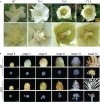A male-sterile mutant with necrosis-like dark spots on anthers was generated in cotton
- PMID: 36699851
- PMCID: PMC9868585
- DOI: 10.3389/fpls.2022.1102196
A male-sterile mutant with necrosis-like dark spots on anthers was generated in cotton
Abstract
Although conventional hybrid breeding has paved the way for improving cotton production and other properties, it is undoubtedly time and labor consuming, while the cultivation of male sterile line can fix the problem. Here, we induced male sterile mutants by simultaneously editing three cotton EXCESS MICROSPOROCYTES1 (GhEMS1) genes by CRISPR/Cas9. Notably, the GhEMS1 genes are homologous to AtEMS1 genes, which inhibit the production of middle layer and tapetum cells as well, leading to male sterility in cotton. Interestingly, there are necrosis-like dark spots on the surface of the anthers of GhEMS1s mutants, which is different from AtEMS1 mutant whose anther surface is clean and smooth, suggesting that the function of EMS1 gene has not been uncovered yet. Moreover, we have detected mutations in GhEMS1 genes from T0 to T3 mutant plants, which had necrosis-like dark spots as well, indicating that the mutation of the three GhEMS1 genes could be stably inherited. Dynamic transcriptomes showed plant hormone pathway and anther development genetic network were differential expression in mutant and wild-type anthers. And the lower level of IAA content in the mutant anthers than that in the wild type at four anther developmental stages may be the reason for the male sterility. This study not only facilitates the exploration of the basic research of cotton male sterile lines, but also provides germplasms for accelerating the hybrid breeding in cotton.
Keywords: CRISPR/Cas9; GhEMS1s; cotton; male-sterile line; necrosis-like dark spots.
Copyright © 2023 Zhang, Wu, Li, Xu, Wang, Chang, Zhang, Wang, Liu, Ma, Manghwar, Zhang, Min and Guo.
Conflict of interest statement
The authors declare that the research was conducted in the absence of any commercial or financial relationships that could be construed as a potential conflict of interest.
Figures






Similar articles
-
Proteomic analysis of anthers from wild-type and photosensitive genetic male sterile mutant cotton (Gossypium hirsutum L.).BMC Plant Biol. 2014 Dec 30;14:390. doi: 10.1186/s12870-014-0390-4. BMC Plant Biol. 2014. PMID: 25547499 Free PMC article.
-
Deficiencies in the formation and regulation of anther cuticle and tryphine contribute to male sterility in cotton PGMS line.BMC Genomics. 2020 Nov 23;21(1):825. doi: 10.1186/s12864-020-07250-1. BMC Genomics. 2020. PMID: 33228563 Free PMC article.
-
Gh4CL20/20A involved in flavonoid biosynthesis is essential for male fertility in cotton (Gossypium hirsutum L.).Plant Physiol Biochem. 2024 Mar;208:108484. doi: 10.1016/j.plaphy.2024.108484. Epub 2024 Mar 2. Plant Physiol Biochem. 2024. PMID: 38452452
-
iTRAQ-facilitated proteomic profiling of anthers from a photosensitive male sterile mutant and wild-type cotton (Gossypium hirsutum L.).J Proteomics. 2015 Aug 3;126:68-81. doi: 10.1016/j.jprot.2015.05.031. Epub 2015 Jun 3. J Proteomics. 2015. PMID: 26047712
-
Perennial Cotton Ratoon Cultivation: A Sustainable Method for Cotton Production and Breeding.Front Plant Sci. 2022 Jun 6;13:882610. doi: 10.3389/fpls.2022.882610. eCollection 2022. Front Plant Sci. 2022. PMID: 35783984 Free PMC article. Review.
Cited by
-
Brems1 mutation induced tapetum deficiency leading to male sterility in Chinese cabbage (Brassica rapa L. ssp. pekinensis).Theor Appl Genet. 2025 Feb 24;138(3):50. doi: 10.1007/s00122-025-04841-y. Theor Appl Genet. 2025. PMID: 39994009
-
Advances in CRISPR/Cas9-based research related to soybean [Glycine max (Linn.) Merr] molecular breeding.Front Plant Sci. 2023 Aug 30;14:1247707. doi: 10.3389/fpls.2023.1247707. eCollection 2023. Front Plant Sci. 2023. PMID: 37711287 Free PMC article. Review.
-
Mutations in a Leucine-Rich Repeat Receptor-Like Kinase gene result in male sterility and reduction in the number and size of fruit warts in cucumber (Cucumis sativus L.).Theor Appl Genet. 2024 Dec 12;138(1):7. doi: 10.1007/s00122-024-04790-y. Theor Appl Genet. 2024. PMID: 39666020
-
Multiomics Studies on the Effects of High-Temperature Stress on Male Sterility in Gossypium barbadense.Int J Mol Sci. 2025 Apr 14;26(8):3693. doi: 10.3390/ijms26083693. Int J Mol Sci. 2025. PMID: 40332330 Free PMC article.
References
-
- Andrianov V., Borisjuk N., Pogrebnyak N., Brinker A., Dixon J., Spitsin S., et al. . (2010). Tobacco as a production platform for biofuel: Overexpression of arabidopsis DGAT and LEC2 genes increases accumulation and shifts the composition of lipids in green biomass. Plant Biotechnol. J. 8 (3), 277–287. doi: 10.1111/j.1467-7652.2009.00458.x - DOI - PubMed
-
- Chen X., Yang S., Zhang Y., Zhu X., Yang X., Zhang C., et al. . (2021). Generation of male-sterile soybean lines with the CRISPR/Cas9 system. Crop J. 9 (6), 1270–1277. doi: 10.1016/j.cj.2021.05.003 - DOI
LinkOut - more resources
Full Text Sources
Miscellaneous

